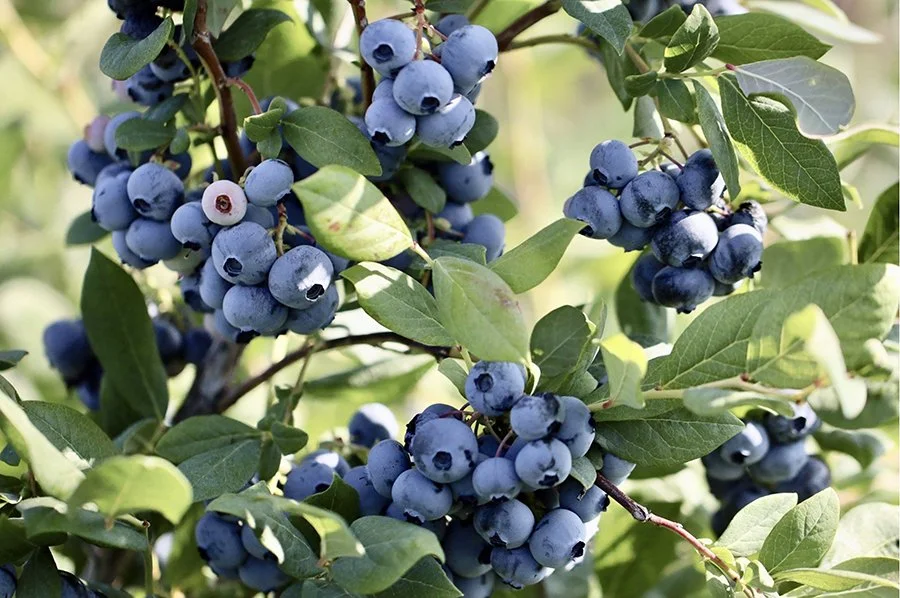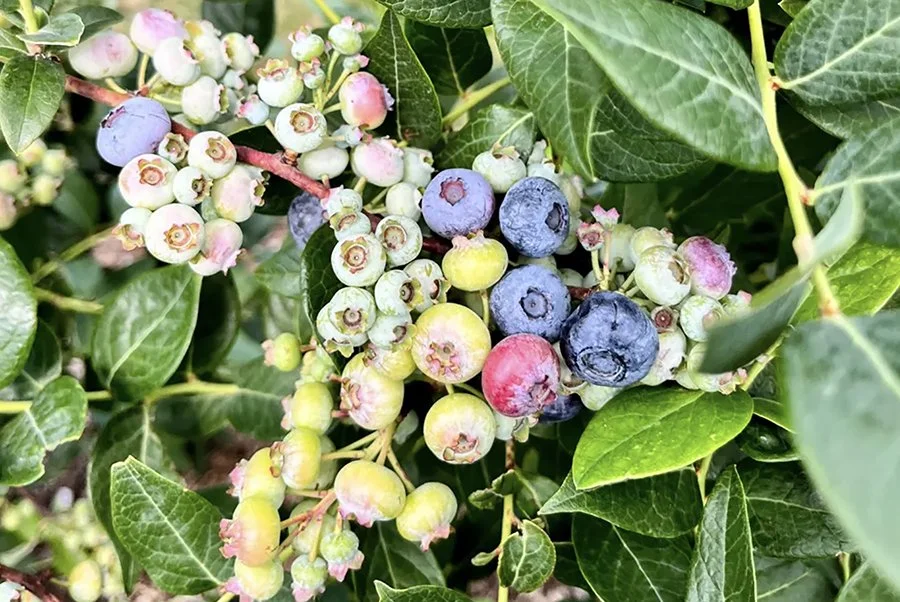Blueberries: The Fruit Of The Summer Season
Fully ripe berries may be easily removed in clumps.
By Thomas P. Caldwell
Nothing says “summer” like fresh blueberries. Not only are they widely available and delicious, they contain antioxidants that protect the body from free radicals — unstable molecules that can damage your cells and contribute to aging and diseases such as cancer.
Beyond the health benefits, blueberries are fun to pick. Unlike harvesting some fruits and vegetables, blueberries tend to fall off the bush right into one’s hand with little effort required. Of course, that means being ready to catch them before they fall to the ground, and not catching them with too much force so that they get crushed. (Experts say the rule is: If you “accidentally” damage a blueberry, you must eat it right away. That hard-and-fast rule may account for the blueberry-pickers who come away with blueberry stains around their mouths.)
Blueberries come in two general categories: high-bush blueberries, which are the most common cultivated variety in the United States; and low-bush or “wild” blueberries, which tend to be smaller but richer in antioxidants.
As a child, we would roam along the electric power lines where wild blueberries grew in profusion. It likely took some time to fill our berry containers, but we had so much fun that we did not really notice how long we were out. While many of the berries undoubtedly reached our mouths, rather than the containers we brought to collect them, we would still come home with full buckets that would be turned into blueberry pies or served with milk in a bowl.
It was not until much later that we decided it was easier and quicker to pick or buy the high-bush varieties, which could fill a container much sooner. When a relative bought a farm with what seemed to be 1,000 blueberry bushes, we were happy to help out with the pruning and picking.
Today, many farms offer pick-your-own blueberry options. In the Lakes Region, they include Norland Berries off Route 28 in Barnstead (603-776-2021), Locke’s Blueberry Farm on North Barnstead Road in Center Barnstead (603-776-2021), Stonybrook Farm on Glidden Road in Gilford (603-293-4300), Triple Trouble Farm on Cherry Valley Road in Gilford, Green Acres Farm on Donkin Hill Road in New Hampton (203-533-9090), and Surowiec Farm on Perley Hill Road in Sanbornton (603-286-4069).
Those who want to grow their own blueberries will need to be sure to pick the varieties that are suited to their area. Also, consider planting a variety of species so they ripen at different times during the season. Multiple varieties also allow for cross-pollination, which means that plants will produce higher-quality berries.
Keep in mind that blueberry bushes prefer soil within a certain acidic range — ideally between pH 4.5 and 5.5.
Pruning the older branches is important because, as they age, the stems produce fewer berries. It is best to prune during the late winter when the plants are dormant to prevent plant shock.
Blueberries ripen at different rates, so a cluster may include diverse colors. Only the bluest are ready for picking.
Blueberries can be ready for picking anytime between mid-June and mid-August, but they do not all ripen at the same time. It is not unusual to see ripe blue or blue-gray berries on the same clump as green, white, or red berries. Pick only the darkest blue ones for the sweetest flavor, but if you accidentally find some reddish ones in your container, they may continue to ripen after picking. Green or white berries will not ripen once they are picked.
There is a bit of art in the picking of the berries. Before starting, it is a good idea to wash your hands, and when you go out, wear a hat — there is not much shade in the blueberry patch. Bring a wide, shallow one-gallon bucket, preferably with a harness to hold it. An early-morning start is best for both the berries and the picker.
When harvesting them, gently roll the berries off the stem and into your palm, then into the bucket or basket. The reason for avoiding a deep, large container is that the weight of the berries can crush those on the bottom.
Later in the season, when full clumps of berries are ripe, you can simply cup them with your hand and, using your thumb, gently coax the berries off the branch without damaging them or including the stems.
Large commercial blueberry growers often abandon manual picking for the faster mechanized harvesting machines, but they are less discerning, and more unripe berries are collected. Hand-picking is a better option; just check out the higher quality of the berries offered at a farmers’ market.
A harvesting tool makes it easier to collect blueberries, but it also may collect leaves and unripened berries
There are manual tools that make the harvesting easier, and they do not result in too many unwanted berries being scooped up with the ripe ones.
One thing to keep in mind when blueberries are ripe: Birds know exactly when that is, and are ready. They will beat you to them if you’re not quick enough. Just a day’s delay may allow them to strip a shrub bare. However, it may be more trouble to protect the berries by placing netting over the bushes, so you might as well resign yourself to sharing the berries with your feathered friends.
If you end up with more blueberries than you can eat right away, they are perfectly good frozen, and they will be ready any time you want to make a batch of blueberry pancakes, blueberry muffins, or another of those blueberry pies.
Besides the wonderful taste, their health benefits make blueberries the perfect “superfood” that is low in calories and good for you (even in a pie). They are among the most nutrient-dense berries, with a one-cup serving providing 13 percent of the daily value for fiber, 14 percent of Vitamin C, and 24 percent of Vitamin K. A cup also contains just 84 calories because of the high water content.
For all those reasons, there is no excuse for not getting out to pick some blueberries this summer, or at least to purchase some at a local farmers’ market. Your taste buds and your healthy body will thank you for the effort.



